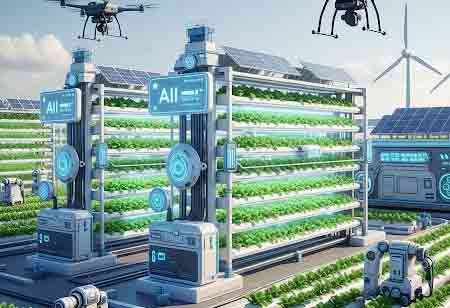Thank you for Subscribing to Agri Business Review Weekly Brief
Building the Future Farm: Integrating Smart Tools for Canadian Growers
Canadian agriculture is transforming through smart farming, utilizing advanced technologies like IoT, AI, and automation to enhance productivity, sustainability, and adaptability in response to climate challenges and global demand.

By
Agri Business Review | Monday, August 04, 2025
Stay ahead of the industry with exclusive feature stories on the top companies, expert insights and the latest news delivered straight to your inbox. Subscribe today.
Fremont, CA: Canadian agriculture, a cornerstone of the nation's economy and food security, is on the cusp of a profound transformation. With evolving climate patterns, increasing global demand, and the urgent need for sustainable practices, Canadian growers are increasingly turning to "smart farming"—integrating advanced technologies to optimize every aspect of agricultural production.
The Dawn of Digital Agriculture in Canada
Smart farming, precision agriculture or digital agriculture uses data, automation, and interconnected devices to improve decision-making, resource management, and productivity. Key technologies driving this revolution include IoT sensors, AI and machine learning, robotics, automation, drones, satellite imagery, crop monitoring, precision mapping, farm management software, blockchain-based traceability, and 5G networks. These technologies are not one-size-fits-all, but rather adaptable to each farm's unique needs and challenges. IoT sensors provide real-time data on water content, nutrients, pH, pest management, and environmental data. AI algorithms forecast crop yields, predict disease outbreaks, and anticipate market demands, while AI-powered computer vision can identify weeds, pests, and signs of crop stress. Robotics and automation address labor shortages and improve efficiency, while drones and satellite imagery provide aerial perspectives. Precision mapping enables the precise mapping of field variations, adjusting the application rate for seeds, fertilizers, and pesticides based on real-time field variability data. Farm management software and data platforms give farmers a holistic overview of field conditions, financial tracking, inventory management, and task scheduling.
Trends in Canadian Smart Agriculture Adoption
Canadian farmers are at the forefront of a technological revolution, increasingly adopting smart technologies to modernize their practices. These technologies, including GPS-guided machinery for precision planting and harvesting, drone and satellite monitoring for real-time crop health insights, IoT sensors for soil health optimization, AI-powered decision making for predictive analytics, and autonomous machinery for labor efficiency, are not just tools but a testament to the farmers' adaptability and innovation. They also focus on sustainability, with a growing emphasis on precision application to reduce environmental impact. Adoption rates vary by farm size and type, but the farmers drive this change.
Economic and Environmental Benefits for Canadian Growers
Smart tools offer numerous economic and ecological benefits. They can increase crop yields and quality, reduce input costs, improve labor efficiency, enhance decision-making, open new revenue streams, and reduce maintenance costs. They also reduce chemical use, promote water conservation, enhance soil health, reduce greenhouse gas emissions, preserve biodiversity, and increase climate change resilience. The precision application of inputs, optimized planting, and early detection of issues can lead to significant yield increases. AI-powered analytics provide informed insights, while real-time data and AI-driven services can open new market opportunities. But even more reassuring is that smart irrigation systems and drought-resistant crop varieties can help farmers adapt to changing weather patterns, ensuring they are always prepared for whatever nature throws.
Canada's smart farming potential is being realized through collaboration from government, industry, academia, and farmers. Investment in research, financial incentives, and infrastructure development is crucial. Tech companies must develop affordable, scalable solutions, making smart farming accessible to all. Meanwhile, academia and research institutions should continue knowledge transfer. This integration of smart tools contributes to a sustainable, resilient, and prosperous future for Canadian agriculture.





